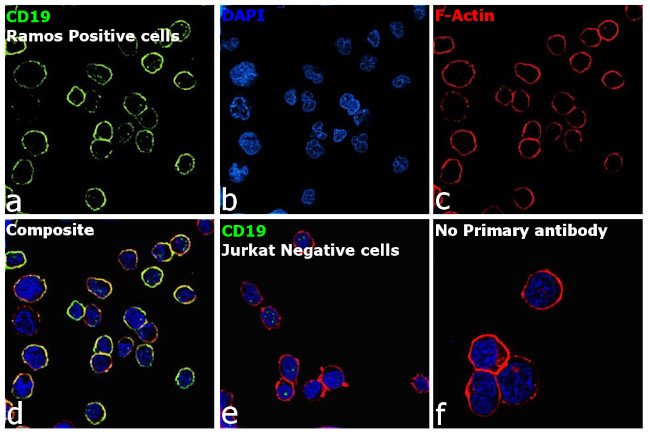Search Thermo Fisher Scientific
Invitrogen
CD19 Monoclonal Antibody (6OMP31), eBioscience™
This Antibody was verified by Knockout to ensure that the antibody binds to the antigen stated.
FIGURE: 1 / 22
CD19 Antibody (14-0194-82) in ICC/IF

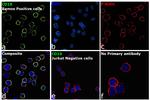
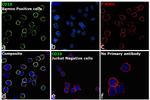

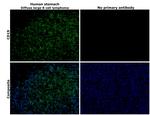

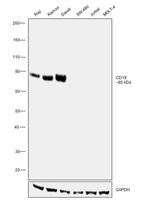
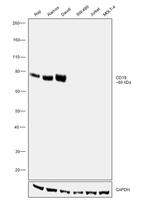
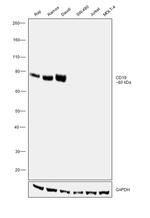
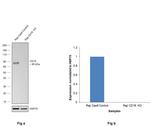

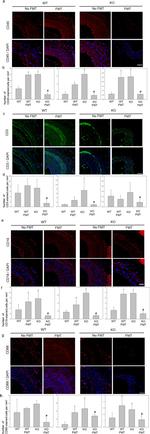
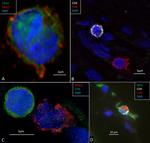
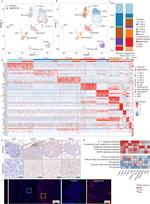

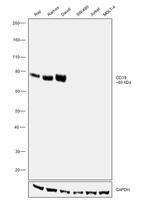
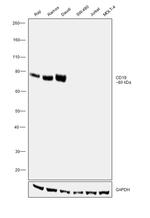
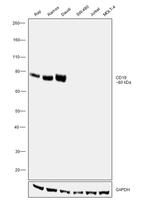
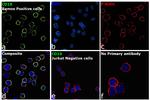
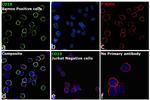
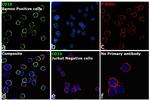
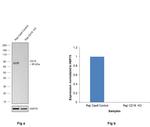
Product Details
14-0194-82
Species Reactivity
Published species
Host/Isotype
Class
Type
Clone
Immunogen
Conjugate
Form
Concentration
Purification
Storage buffer
Contains
Storage conditions
Shipping conditions
RRID
Product Specific Information
Description: The 6OMP31 monoclonal antibody reacts with human, mouse, and rat CD19. CD19 is a transmembrane glycoprotein belonging to the immunoglobulin superfamily. CD19 was first identified as the B4 antigen of human B lymphocytes using the anti-B4 monoclonal. It is expressed by B cells during all stages of development, except on terminally differentiated plasma cells, and on follicular dendritic cells. CD19 acts primarily as a B cell co-receptor and together with CD21, CD81, Leu13, and MHC class II forms a multi-molecular complex that associates with the BCR. CD19 plays a role in the development, activation, differentiation, and proliferation of B cells. CD19 deficiency leads to an overall impaired humoral immune response. Mutations in CD19 have been associated with severe immunodeficiency syndromes. Although it is unclear whether CD19 contributes directly to B cell carcinogenesis, it is expressed on most B cell tumors, such as acute lymphoblastic leukemias and B cell lymphomas. The use of CD19 monoclonal antibodies for therapies against lymphoma, leukemia and autoimmune disorders are currently being explored.
Applications Reported: This 6OMP31 antibody has been reported for use in western blotting, immunohistochemical staining of frozen tissue sections, and immunohistochemical staining of formalin-fixed paraffin embedded tissue sections.
Applications Tested: This 6OMP31 antibody has been tested by immunohistochemistry of formalin-fixed paraffin embedded tissue using low or high pH antigen retrieval and can be used at less than or equal to 0.5 µg/mL. The 6OMP31 antibody has been tested by immunohistochemstry of frozen tissue and can be used at less than or equal to 0.5 µg/mL. It is recommended that the antibody be carefully titrated for optimal performance in the assay of interest.
Purity: Greater than 90%, as determined by SDS-PAGE.
Aggregation: Less than 10%, as determined by HPLC.
Filtration: 0.2 µm post-manufacturing filtered.
Target Information
CD19 is a member of the immunoglobulin superfamily and has two Ig like domains. The CD19 molecule is expressed on 100% of the peripheral B cells as defined by expression of kappa or lambda light chains. CD19 appears to be expressed on myeloid leukemia cells, particularly those of monocytic lineage. Leukemia phenotype studies have demonstrated that the earliest and broadest B cell restricted antigen is the CD19 antigen. The receptor for CD19 is an important functional regulator of normal and malignant B cell proliferation, and is expressed in all B cell precursor leukemias. Lymphocytes proliferate and differentiate in response to various concentrations of different antigens. The ability of the B cell to respond in a specific, yet sensitive manner to the various antigens is achieved with the use of low-affinity antigen receptors. CD19 is a cell surface molecule which assembles with the antigen receptor of B lymphocytes in order to decrease the threshold for antigen receptor-dependent stimulation. Besides being a signal-amplifying coreceptor for the B cell receptor (BCR), CD19 can also signal independently of BCR co-ligation and is a central regulatory component upon which multiple signaling pathways converge. Mutation of the CD19 gene results in hypogammaglobulinemia, whereas CD19 overexpression causes B cell hyperactivity.
For Research Use Only. Not for use in diagnostic procedures. Not for resale without express authorization.
Bioinformatics
Protein Aliases: B-lymphocyte antigen CD19; B-lymphocyte surface antigen B4; CD19; CD19 antigen; Differentiation antigen CD19; Leu-12; T-cell surface antigen Leu-12
Gene Aliases: AW495831; B4; CD19; CVID3
UniProt ID: (Human) P15391, (Mouse) P25918
Entrez Gene ID: (Human) 930, (Mouse) 12478, (Rat) 365367

Performance Guarantee
If an Invitrogen™ antibody doesn't perform as described on our website or datasheet,we'll replace the product at no cost to you, or provide you with a credit for a future purchase.*
Learn more
We're here to help
Get expert recommendations for common problems or connect directly with an on staff expert for technical assistance related to applications, equipment and general product use.
Contact tech support
